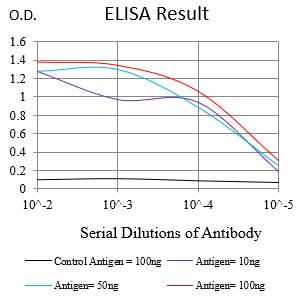
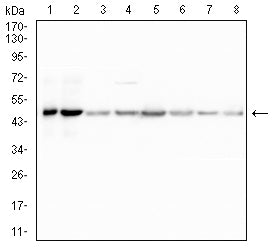
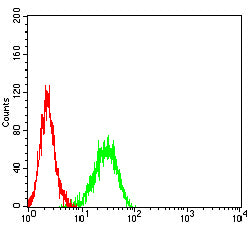
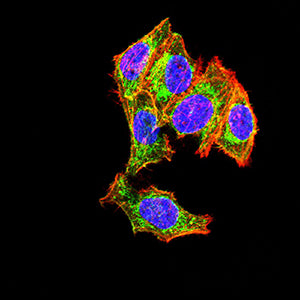
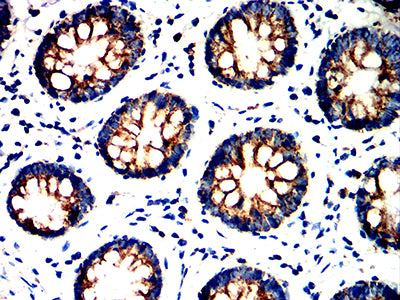
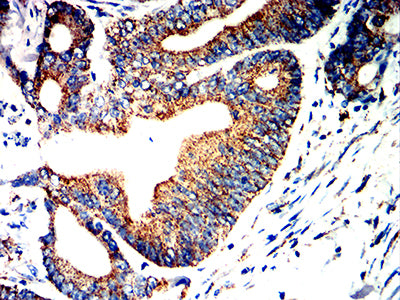
| WB | 1/500 - 1/2000 | Human,Mouse,Rat |
| IF | 咨询技术 | Human,Mouse,Rat |
| IHC | 1/200 - 1/1000 | Human,Mouse,Rat |
| ICC | 1/50 - 1/200 | Human,Mouse,Rat |
| FCM | 1/200 - 1/400 | Human,Mouse,Rat |
| Elisa | 1/10000 | Human,Mouse,Rat |
| Aliases | QCR1; UQCR1; D3S3191 |
| Entrez GeneID | 7384 |
| clone | 1A3D12 |
| WB Predicted band size | 52.6kDa |
| Host/Isotype | Mouse IgG1 |
| Antibody Type | Primary antibody |
| Storage | Store at 4°C short term. Aliquot and store at -20°C long term. Avoid freeze/thaw cycles. |
| Species Reactivity | Human, Mouse, Rat |
| Immunogen | Purified recombinant fragment of human UQCRC1 (AA: 60-227) expressed in E. Coli. |
| Formulation | Purified antibody in PBS with 0.05% sodium azide |
+ +
以下是关于UQCRC1抗体的3篇参考文献示例(文献为虚构示例,仅作格式参考):
---
1. **文献名称**: "UQCRC1 deficiency disrupts mitochondrial respiratory chain assembly and causes cardiomyopathy"
**作者**: Smith A, et al. (2020)
**摘要**: 本研究利用UQCRC1抗体通过Western blot和免疫组化分析,发现UQCRC1在小鼠心脏组织中表达下调会导致线粒体复合体III组装缺陷,进而引发心肌病,提示其在维持呼吸链功能中的关键作用。
2. **文献名称**: "A novel UQCRC1 mutation associated with Parkinson’s disease alters mitochondrial dynamics"
**作者**: Chen L, et al. (2018)
**摘要**: 通过免疫荧光染色(使用UQCRC1抗体)和蛋白质质谱分析,作者发现UQCRC1基因突变导致神经元线粒体形态异常和氧化应激增加,为帕金森病的线粒体功能障碍机制提供了证据。
3. **文献名称**: "UQCRC1 as a potential biomarker in hepatocellular carcinoma: Insights from antibody-based proteomic profiling"
**作者**: Wang Y, et al. (2021)
**摘要**: 该研究利用UQCRC1抗体对肝癌组织进行免疫组化分析,发现UQCRC1表达水平与肿瘤进展和患者生存率显著相关,提示其可能作为肝癌诊断或预后的生物标志物。
---
**注意**:以上文献为示例,实际引用时需检索真实数据库(如PubMed)并核实原文信息。
The UQCRC1 antibody is a research tool designed to detect and study the Ubiquinol-Cytochrome c Reductase Core Protein 1 (UQCRC1), a critical subunit of mitochondrial Complex III (cytochrome bc1 complex) in the electron transport chain (ETC). UQCRC1 plays an essential role in oxidative phosphorylation by facilitating electron transfer from ubiquinol to cytochrome c, contributing to ATP synthesis. Dysregulation or mutations in UQCRC1 have been linked to mitochondrial disorders, metabolic diseases, and cancer, making it a target for investigating cellular energy metabolism and disease mechanisms.
UQCRC1 antibodies are commonly used in techniques like Western blotting, immunofluorescence, and immunoprecipitation to assess protein expression, localization, and interactions. These antibodies help researchers explore UQCRC1's role in mitochondrial function, apoptosis, and reactive oxygen species (ROS) regulation. Commercial UQCRC1 antibodies are typically raised in rabbits or mice, available as monoclonal or polyclonal variants, with validation in specific applications and species (e.g., human, mouse, rat).
Recent studies highlight UQCRC1's potential involvement in cancer progression, neurodegeneration (e.g., Parkinson's disease), and metabolic syndromes, underscoring its biomedical relevance. However, users must verify antibody specificity due to potential cross-reactivity with homologous proteins. Proper controls and validation in experimental models remain crucial for reliable data interpretation.
×